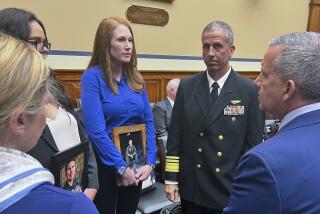Congressmen Launch Effort to Boost National Aerospace Plane
WASHINGTON — Concerned about burgeoning costs and troubling delays, California congressmen--including one from Orange County--on Tuesday launched a campaign to dramatically retool the troubled, $12.5-billion effort to build a National Aerospace Plane.
The goal of the project, which involves a host of California contractors, including Seal Beach-based Rockwell International, is to develop an experimental aircraft that can fly from a standing start on a runway into Earth orbit at speeds of Mach 25--17,000 m.p.h.--using air-fed engines to replace or complement rockets.
At a congressional hearing, Rep. George E. Brown Jr. (D-Colton) unveiled legislation that would direct the Department of Defense and the National Aeronautics and Space Administration, which share responsibility for the project, to drastically cut the size, cost and production schedule of the proposed X-30, or NASP, as the craft is known.
“We seem to be no closer today than we were six years ago to achieving the first orbital flight,” said Brown, who chairs the House Committee on Science, Space and Technology.
“With this year’s budget cuts threatening the program, NASP could be permanently grounded unless we develop a new approach for the effort.”
Brown was strongly supported by Rep. Dana Rohrabacher (R-Huntington Beach), who said that preserving the X-30 project is critical to the nation’s military security and its economic competitiveness.
“It will really determine whether America is going to be the No. 1 aerospace power in the world a decade from now or two decades from now,” Rohrabacher said. “We could blink our eyes and wake up . . . and find out we are no longer masters of the air.”
The Brown legislation, which will await action until the 103rd Congress convenes in January, calls for reducing the space plane’s cost to $5 billion, scaling back its weight from 350,000 to 50,000 pounds, and delivering a prototype in five years, instead of the planned seven.
Brown said the precise weight of the plane is open to discussion. But he added that his bill is intended to serve notice that NASP program managers should concentrate on building a true experimental space plane rather than a larger, more fully refined craft.
Supporters argue that a hypersonic aerospace plane could provide access to space that is at once faster and much less expensive than that provided by the space shuttle. But critics complain that neither President Bush nor President Reagan, who made production of the space plane a presidential priority 1986, have ever properly justified the cost of the program. When Reagan announced his support for the space plane, its cost was pegged at less than $4 billion.
Faced with growing cost estimates, the Bush Administration announced in 1989 that it would reduce annual expenditures on NASP by temporarily shifting the program’s emphasis to materials research, and would delay until 1993 a decision on whether to go ahead and build an X-30 prototype.
The project already has cost about $2.5 billion, about $1 billion of which has come from five private contractors.
Congressional support, meanwhile, has been tepid. This year Congress eliminated all of the $80 million that NASA had requested for work on the space plane in fiscal 1993, which begins Oct. 1.The Senate approved $175 million for the Defense Department’s share of the work, but the House gave nothing.
More to Read
Get the L.A. Times Politics newsletter
Deeply reported insights into legislation, politics and policy from Sacramento, Washington and beyond. In your inbox three times per week.
You may occasionally receive promotional content from the Los Angeles Times.










